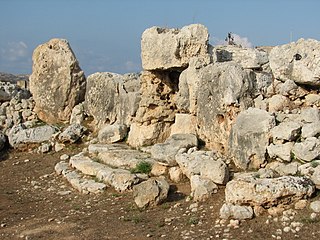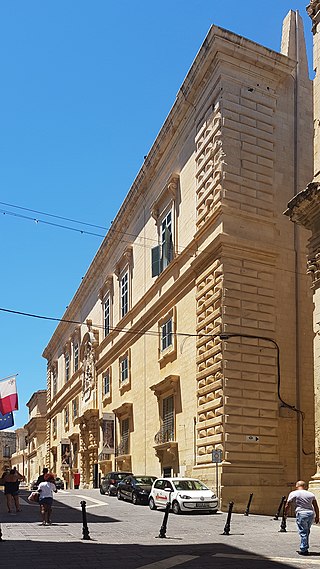
The Hypogeum of Ħal Saflieni is a Neolithic subterranean structure dating to the Saflieni phase in Maltese prehistory, located in Paola, Malta. It is often simply referred to as the Hypogeum, literally meaning "underground" in Greek. The Hypogeum is thought to have been a sanctuary and necropolis, with the estimated remains of more than 7,000 people documented by archeologists, and is among the best preserved examples of the Maltese temple building culture that also produced the Megalithic Temples and Xagħra Stone Circle.

The Xagħra Stone Circle, also known as the Xagħra Hypogeum or the Brochtorff Circle, is a Neolithic funerary complex located in Xagħra, Gozo, Malta. It consists of a series of caves which were used to bury the dead, and which were surrounded by a walled enclosure. It mainly dates back to around 3000 to 2400 BC, although the earliest tombs at the site date back to 4100 to 3800 BC. The caves collapsed sometime before 2000 BC, and the site was later used for domestic and agricultural purposes.

Ħaġar Qim is a megalithic temple complex found on the Mediterranean island of Malta, dating from the Ġgantija phase (3600–3200 BC). The Megalithic Temples of Malta are among the most ancient religious sites on Earth, described by the World Heritage Sites committee as "unique architectural masterpieces." In 1992 UNESCO recognized Ħaġar Qim and four other Maltese megalithic structures as World Heritage Sites. V. Gordon Childe, Professor of Prehistoric European Archeology and director of the Institute of Archaeology in the University of London from 1946-1957 visited Ħaġar Qim. He wrote, "I have been visiting the prehistoric ruins all round the Mediterranean, from Mesopotamia to Egypt, Greece and Switzerland, but I have nowhere seen a place as old as this one."

The Megalithic Temples of Malta are several prehistoric temples, some of which are UNESCO World Heritage Sites, built during three distinct periods approximately between 3600 BC and 2500 BC on the island country of Malta. They had been claimed as the oldest free-standing structures on Earth until the discovery of Göbekli Tepe in Turkey. Archaeologists believe that these megalithic complexes are the result of local innovations in a process of cultural evolution. This led to the building of several temples of the Ġgantija phase, culminating in the large Tarxien temple complex, which remained in use until 2500 BC. After this date, the temple-building culture disappeared.

The National Museum of Beirut is the principal museum of archaeology in Lebanon. The collection begun after World War I, and the museum was officially opened in 1942. The museum has collections totaling about 100,000 objects, most of which are antiquities and medieval finds from excavations undertaken by the Directorate General of Antiquities.

The Skorba temples are megalithic remains on the northern edge of Żebbiegħ, in the Northern Region of Malta, which have provided detailed and informative insight into the earliest periods of Malta's neolithic culture. The site was only excavated in the early 1960s, rather late in comparison to other megalithic sites, some of which had been studied since the early 19th century. The site's importance has led to its listing as a UNESCO World Heritage Site, a listing it shares with six other megalithic temples in Malta.
This page list topics related to Malta.

The Tarxien Temples are an archaeological complex in Tarxien, in the Port region of Malta. They date to approximately 3150 BC. The site was accepted as a UNESCO World Heritage Site in 1992 along with the other Megalithic temples on the island of Malta.

The Ta' Ħaġrat temples in Mġarr, Malta are recognized as a UNESCO World Heritage Site, along with several other Megalithic temples. They are amongst the world's oldest religious sites. The larger Ta' Ħaġrat temple dates from the Ġgantija phase ; the smaller temple is dated to the Saflieni phase.
The Saflieni phase is one of the eleven phases of Maltese prehistory, the fourth of five in the middle or Temple period. It is named for the Ħal-Saflieni Hypogeum, an underground temple complex now recognised as a World Heritage Site by UNESCO, which was built mainly in this period.
The Mġarr phase is one of the eleven phases of Maltese prehistory. It is named for the town of Mġarr, in the west of the island, where pottery older than the Ta' Ħaġrat temple complex was found.
The Tarxien phase is one of the eleven phases of Maltese prehistory. It is named for the temple complex discovered near the village of Ħal Tarxien, and now recognised as a World Heritage Site by UNESCO.

Tas-Silġ is a rounded hilltop on the south-east coast of the island of Malta, overlooking Marsaxlokk Bay, and close to the town of Żejtun. Tas-Silġ is a major multi-period sanctuary site with archaeological remains covering four thousand years, from the neolithic to the ninth century AD. The site includes a megalithic temple complex dating from the early third millennium BC, to a Phoenician and Punic sanctuary dedicated to the goddess Astarte. During the Roman era, the site became an international religious complex dedicated to the goddess Juno, helped by its location along major maritime trading routes, with the site being mentioned by first-century BC orator Cicero.

Auberge de Provence is an auberge in Valletta, Malta. It was built in the sixteenth century to house knights of the Order of Saint John from the langue of Provence. It now houses the National Museum of Archaeology.

The Auberge d'Italie is an auberge in Valletta, Malta. It was built at various stages in the late 16th century to house knights of the Order of Saint John from the langue of Italy, and it originally had a Mannerist design by Girolamo Cassar and several other architects. The building continued to be modified throughout the course of the 17th century, with the last major renovation being carried out in the 1680s during the magistracy of Gregorio Carafa, giving the building a Baroque character.
The Kordin Temples are a group of megalithic temples on Corradino Heights in Paola, Malta. The temples were inhabited from pre-history, by Phoenicians and then by the Greeks and Roman periods. In the 17th century the site belonged to Giovanni Francesco Abela. He had excavated several sites in the whereabouts, and had his country residence in the area. He had originally planned to write his will to the Order, but eventually left his villa, that was used as Malta's first museum, known as Museo di San Giacomo, and the surrounding lands to the Jesuits. The land still belonged to the Jesuits, until their expulsion in the 18th century by the Order when all their land and property was taken by the treasury. The site was excavated during the Order of St. John on the order of Grand Master Manuel Pinto da Fonseca by archeologist Gio Antonio Barbaro. The temples were then extensively excavated by Sir Themistocles Zammit during the British period.

Melite or Melita (Latin) was an ancient city located on the site of present-day Mdina and Rabat, Malta. It started out as a Bronze Age settlement, which developed into a city called Ann under the Phoenicians and became the administrative centre of the island. The city fell to the Roman Republic in 218 BC, and it remained part of the Roman and later the Byzantine Empire until 870 AD, when it was captured and destroyed by the Aghlabids. The city was then rebuilt and renamed Medina, giving rise to the present name Mdina. It remained Malta's capital city until 1530.
David Hilary Trump was a British archaeologist known for his work in the area of Maltese prehistory. In 1954, Trump helped John Davies Evans excavate at Ġgantija. He took part in the excavation of many important sites in Maltese prehistory, including the Skorba Temples and Xagħra Stone Circle. From 1958–1963, he was a curator at the National Museum of Archaeology, Malta. He retired in 1997. He was awarded the National Order of Merit by Malta in 2004.
The Ħal Ġinwi temple was a prehistoric megalithic temple site located southeast of Żejtun, Malta dating back to the Ġgantija phase. The site is located in an area bearing the same name, or alternatively Ħal Ġilwi, which is known for its archaeological remains, and lies around one kilometre from the Tas-Silġ multi-period sanctuary and archaeological site.

The remains of an unidentified Punic building exist incorporated into several properties in Żurrieq, Malta. They include a well-preserved structure commonly known as the Punic Tower or the Żurrieq Tower which is found inside the private garden of the Domus Curialis, the house of the town's archpriest, and which is the most substantial surviving example of Punic architecture on the island.























